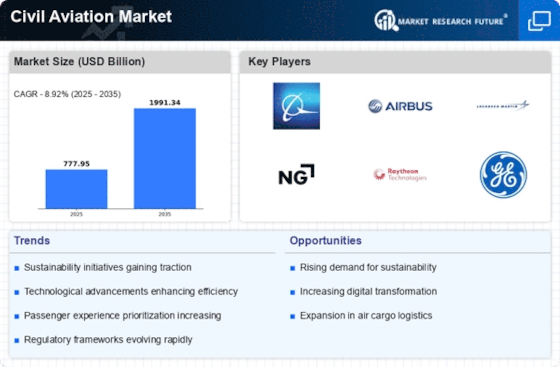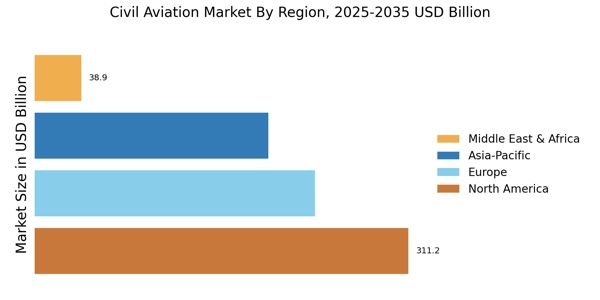The Civil Aviation Industry Market is currently characterized by a dynamic competitive landscape, driven by technological advancements, sustainability initiatives, and evolving consumer preferences. Major players such as Boeing (US), Airbus (FR), and Raytheon Technologies (US) are at the forefront, each adopting distinct strategies to enhance their market positioning. Boeing (US) continues to focus on innovation in aircraft design and manufacturing processes, while Airbus (FR) emphasizes sustainability through its commitment to developing hydrogen-powered aircraft. Raytheon Technologies (US) is leveraging its expertise in aerospace systems to integrate advanced technologies into its offerings, thereby enhancing operational efficiency and safety. Collectively, these strategies not only shape the competitive environment but also reflect a broader industry trend towards modernization and environmental responsibility.
In terms of business tactics, companies are increasingly localizing manufacturing to mitigate supply chain disruptions and optimize operational efficiency. This trend is particularly evident in the context of a moderately fragmented market structure, where key players exert considerable influence. The collective actions of these companies suggest a concerted effort to enhance resilience and adaptability in an ever-evolving market landscape. As firms navigate challenges, the focus on supply chain optimization and localized production is likely to intensify, further shaping competitive dynamics.
In August 2025, Boeing (US) announced a strategic partnership with a leading technology firm to develop next-generation avionics systems. This collaboration aims to enhance the safety and efficiency of commercial aircraft, positioning Boeing as a leader in technological innovation. The strategic importance of this partnership lies in its potential to streamline operations and improve customer satisfaction, thereby reinforcing Boeing's competitive edge in the market.
In September 2025, Airbus (FR) unveiled its ambitious plan to launch a new line of eco-friendly aircraft powered by hydrogen fuel cells. This initiative not only aligns with global sustainability goals but also positions Airbus as a pioneer in the transition towards greener aviation solutions. The strategic significance of this move is profound, as it could redefine industry standards and attract environmentally conscious consumers, thereby enhancing Airbus's market share.
In October 2025, Raytheon Technologies (US) revealed its investment in artificial intelligence-driven predictive maintenance solutions for aircraft. This strategic action aims to reduce operational costs and improve aircraft reliability, reflecting a broader trend towards digital transformation in the aviation sector. The implications of this investment are substantial, as it positions Raytheon Technologies at the forefront of technological advancements, potentially reshaping maintenance practices across the industry.
As of October 2025, the competitive trends within the Civil Aviation Industry are increasingly defined by digitalization, sustainability, and the integration of artificial intelligence. Strategic alliances are becoming pivotal in shaping the current landscape, as companies collaborate to leverage complementary strengths. Looking ahead, competitive differentiation is likely to evolve, with a pronounced shift from price-based competition to a focus on innovation, technological advancements, and supply chain reliability. This evolution underscores the necessity for companies to adapt and innovate continuously in order to maintain a competitive advantage in a rapidly changing market.



















Leave a Comment